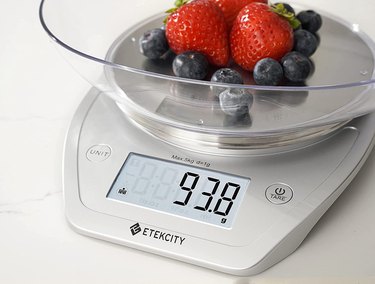Digital scales are a convenient tool, whether you're in the kitchen, shipping packages, or monitoring your weight. When using digital for weighing, scale settings accuracy is essential. You may need to adjust or calibrate your scale at regular intervals or after moving it from one location to another to ensure that it continues to provide the correct weight.
Using a Digital Scale
Video of the Day
From the kitchen to the office to the bathroom, digital scales provide a reasonably accurate measure. Digital scales work best when stored and used at room temperature. Extremes of temperature, as well as dust, moisture, and vibrations, can affect the accuracy of the scale. In addition, low batteries may result in inaccurate weights.
Video of the Day
Place the scale on a flat, hard surface, whether it is the floor, desk, or kitchen counter. Make sure the feet are all clean and touching the underlying surface. If the weight fluctuates when weighing the same item, you may need new batteries.
When using a bathroom scale, step on and then off the scale. Allow it to go to zero before stepping back onto the scale to weigh yourself. Hold still, as moving around may result in an error code or an inaccurate weight. An error code may require further troubleshooting; consult the owner's manual before replacing the scale.
Changing Digital Weighing Scale Settings
Digital kitchen scales often have the option of pounds and ounces or kilograms and grams, which is handy when preparing recipes from UK or European sources, eliminating the need for a cheat sheet. Digital bathroom scales usually have a tiny switch on the bottom or side, while kitchen scales have a "Kg/Lb" or "Unit" button that allows you to quickly change the unit of measure.
When you turn on the scale, the display will show which unit of measure is being used. The next time you use the scale, it will automatically return to the same setting, so if you're switching back and forth, be sure to check the display to ensure that you're using the correct measure.
Applying the Tare Function
The tare feature allows you to place a bowl or other container on the scale and zero out the weight, thus assuring an accurate measurement. Place the bowl on the scale and then press the "On/Off" or "Tare" button. After the scale reads zero, add the item or ingredient to the bowl.
If you're weighing more than one item that will end up in the same bowl, such as the flour, baking soda, and salt in a recipe, press the "Tare" button following the addition of each ingredient to return the scale to zero before adding the next item. When the scale reaches the correct number of pounds and/or ounces, press the "Tare" button again. Repeat as needed until all of the ingredients are in the bowl.
Calibrating Digital Scales
Most digital scales intended for personal use do not have a method of recalibration. If you're weighing items that require an accuracy level of 0.01 or 0.001 grams, such as in jewelry making, reloading shotgun shells, or preparing medications, you need a high-quality precision scale manufactured for professional or scientific use. If used frequently, you may have to recalibrate it daily or if used infrequently, each time you move the scale.
For general use or weighing packages for shipping, you can check the accuracy of your scale using coins. The legal requirements of U.S. coins provide that a new nickel is 5.0 grams, and a quarter is 5.67 grams. However, using coins to calibrate your scale is not suitable for precise calibration, as worn or dirty coins may weigh less or more than a brand-new coin straight from the mint. A calibration weight is a better choice if you need exact measurements.
To calibrate your scale, place the scale on a flat surface and turn it on. Begin the calibration sequence according to the user manual. Place the calibration weight on the scale per the instructions on the display and if the function is available, input the weight. Continue to follow the display instructions until the sequence is complete and then return the scale to the normal mode.
